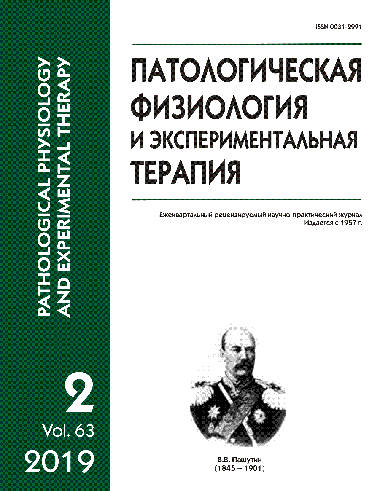About the pathogenesis of peliosis hepatis
Abstract
Aim. Characterization of peliosis hepatis using immunohistochemical methods. Methods. The study was performed on archive autopsy samples from patients (n=4) with peliosis hepatis using histological, histochemical (AgNO3 impregnation), and immunohistochemical methods. Murine monoclonal antibodies, anticollagen type III, anticollagen type IV, anti-α-smooth muscle actin, anti-CD31, anti-CD34, and anti-Ki-67 (Novocastra, UK), were used as primary antibodies, and all-purpose antibodies (HiDef Detection ™ HRP Polymer system, Cell Marque:, USA) were used as secondary antibodies. Intensity of immunohistochemical staining was expressed as scores: 1+ = 1-10% of cells, 2+ = 11-50% of cells, and 3+ = ≥51% of cells. Results. The cyst wall consisted of sclerotic fibrous tissue with pronounced mononuclear infiltration, accumulation of hemosiderin in periportal tracts, and zones of piecemeal necrosis. Multifocal, sinusoidal ectasias filled with blood and/or plasma components encompassing all three zones of the hepatic lobe were observed in the adjacent hepatic parenchyma. Histochemical study revealed reticular fibers without signs of destruction in these formations. Immunohistochemical analysis found increased expression of collagen III (96.6±0.2%), collagen IV (97.2±0.3%), and α-SMA (94%±0.5) along sinusoids and cavity lining. The endothelial expression of CD31 (87.3±0.6%) and CD34 (86.3±0.2%) decreased on going from the hepatic triad to the central vein. The expression index, Ki-67, was increased in sinusoid macrophages (28.3±0.2%) and lymphocytes (12.3±0.7%). Reactions to β-catenin, CD10 and pCEA were immune-negative, which excluded tumor growth. Conclusion. The study suggested that the active synthesis of extracellular matrix proteins and the immune cell proliferation are key processes in the pathogenesis of peliosis hepatis during destruction of endothelial communications in hepatic lobes.






